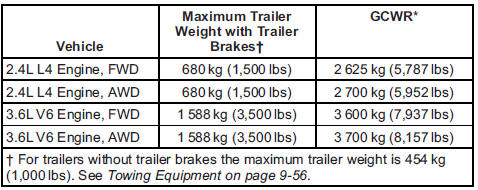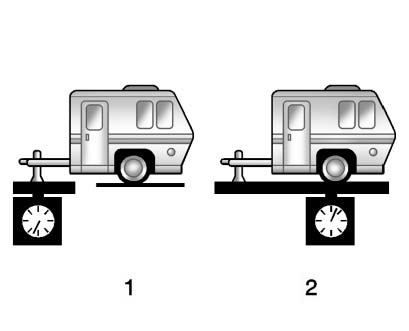
Chevrolet Equinox Owners Manual
TowingDriving and Operating / Towing
General Towing Information
Only use towing equipment that has been designed for the vehicle.
Contact your dealer or trailering dealer for assistance with preparing the vehicle for towing a trailer. Read the entire section before towing a trailer.
Driving Characteristics and Towing Tips
Driving with a Trailer
When towing a trailer:
• Become familiar with the state and local laws that apply specifically to trailer
towing.
• Do not tow a trailer during the first 800 km (500 miles), to prevent damage to
the engine, axle or other parts.
• Then, during the first 800 km (500 miles) trailer towing, do not drive over 80
km/h (50 mph) and do not make starts at full throttle.
• The vehicle can tow in D (Drive).
Use a lower gear if the transmission shifts too often.
• Do not use the Fuel Economy Mode when towing.
WARNING
When towing a trailer, exhaust gases may collect at the rear of the vehicle and enter if the liftgate, trunk/hatch, or rear-most window is open.
When towing a trailer:
• Do not drive with the liftgate, trunk/hatch, or rear-most window open.
• Fully open the air outlets on or under the instrument panel.
• Also adjust the Climate Control system to a setting that brings in only outside
air.
See “Climate Control Systems” in the Index.
Towing a trailer requires a certain amount of experience. The combination you are driving is longer and not as responsive as the vehicle itself. Get acquainted with the handling and braking of the rig before setting out for the open road.
Before starting, check all trailer hitch parts and attachments, safety chains, electrical connectors, lamps, tires and mirrors. If the trailer has electric brakes, start the combination moving and then apply the trailer brake controller by hand to be sure the brakes work.
During the trip, check occasionally to be sure that the load is secure and the lamps and any trailer brakes still work.
Towing with a Stability Control System
When towing, the sound of the stability control system might be heard. The system is reacting to the vehicle movement caused by the trailer, which mainly occurs during cornering. This is normal when towing heavier trailers.
Following Distance
Stay at least twice as far behind the vehicle ahead as you would when driving the vehicle without a trailer.
This can help to avoid situations that require heavy braking and sudden turns.
Passing
More passing distance is needed when towing a trailer. Because the rig is longer, it is necessary to go farther beyond the passed vehicle before returning to the lane.
Backing Up
Hold the bottom of the steering wheel with one hand. To move the trailer to the left, move your hand to the left. To move the trailer to the right, move your hand to the right.
Always back up slowly and, if possible, have someone guide you.
Making Turns
Notice: Making very sharp turns while trailering could cause the trailer to come in contact with the vehicle. The vehicle could be damaged. Avoid making very sharp turns while trailering.
When turning with a trailer, make wider turns than normal so the trailer will not strike soft shoulders, curbs, road signs, trees or other objects. Use the turn signal well in advance and avoid jerky or sudden maneuvers.
Turn Signals When Towing a Trailer
The turn signal indicators on the instrument panel flash whenever signaling a turn or lane change.
Properly hooked up, the trailer lamps also flash, telling other drivers the vehicle is turning, changing lanes or stopping.
When towing a trailer, the arrows on the instrument panel flash for turns even if the bulbs on the trailer are burned out. Check occasionally to be sure the trailer bulbs are still working.
Driving on Grades
Reduce speed and shift to a lower gear before starting down a long or steep downgrade. If the transmission is not shifted down, the brakes might have to be used so much that they would get hot and no longer work well.
The vehicle can tow in D (Drive).
Use a lower gear if the transmission shifts too often.
When towing at high altitude on steep uphill grades, engine coolant boils at a lower temperature than at normal altitudes. If the engine is turned off immediately after towing at high altitude on steep uphill grades, the vehicle could show signs similar to engine overheating.
To avoid this, let the engine run while parked, preferably on level ground, with the transmission in P (Park) for a few minutes before turning the engine off.
Parking on Hills
WARNING
Parking the vehicle on a hill with the trailer attached can be dangerous. If something goes wrong, the rig could start to move.
People can be injured, and both the vehicle and the trailer can be damaged. When possible, always park the rig on a flat surface.
If parking the rig on a hill:
1. Press the brake pedal, but do not shift into P (Park) yet. Turn the wheels
into the curb if facing downhill or into traffic if facing uphill.
2. Have someone place chocks under the trailer wheels.
3. When the wheel chocks are in place, release the brake pedal until the chocks
absorb the load.
4. Reapply the brake pedal. Then apply the parking brake and shift into P (Park).
5. Release the brake pedal.
Leaving After Parking on a Hill
1. Apply and hold the brake pedal while you:
• Start the engine.
• Shift into a gear.
• Release the parking brake.
2. Let up on the brake pedal.
3. Drive slowly until the trailer is clear of the chocks.
4. Stop and have someone pick up and store the chocks.
Maintenance When Trailer Towing
The vehicle needs service more often when pulling a trailer. Things that are especially important in trailer operation are automatic transmission fluid, engine oil, axle lubricant, belts, cooling system and brake system. Inspect these before and during the trip.
Check periodically to see that all hitch nuts and bolts are tight.
Engine Cooling When Trailer Towing
The cooling system may temporarily overheat during severe operating conditions.
Trailer Towing
Before pulling a trailer, there are three important considerations that have to do with weight:
• The weight of the trailer
. The weight of the trailer tongue
. The total weight on the vehicle's tires
Weight of the Trailer
How heavy can a trailer safely be? Speed, altitude, road grades, outside temperature, special equipment, and the amount of tongue weight the vehicle can carry must be considered. See “Weight of the Trailer Tongue” later in this section.
Maximum trailer weight is calculated assuming only the driver is in the tow vehicle and it has all the required trailering equipment. The weight of additional optional equipment, passengers and cargo in the tow vehicle must be subtracted from the maximum trailer weight.
Use the following chart to determine how much the vehicle can weigh, based upon the vehicle model and options.

*The Gross Combination Weight Rating (GCWR) is the total allowable weight of the completely loaded vehicle and trailer including any passengers, cargo, equipment and conversions. The GCWR for the vehicle should not be exceeded.
Ask your dealer for our trailering information or advice.
Weight of the Trailer Tongue
The tongue load (1) of any trailer is an important weight to measure because it affects the total gross weight of the vehicle. The Gross Vehicle Weight (GVW) includes the curb weight of the vehicle, any cargo carried in it, and the people who will be riding in the vehicle.
If there are a lot of options, equipment, passengers or cargo in the vehicle, it will reduce the tongue weight the vehicle can carry, which will also reduce the trailer weight the vehicle can tow. If towing a trailer, the tongue load must be added to the GVW because the vehicle will be carrying that weight, too.

If a weight-carrying hitch or a weight-distributing hitch is being used, the trailer tongue (1) should weigh 10 to 15 percent of the total loaded trailer weight (2).
After loading the trailer, weigh the trailer and then the tongue, separately, to see if the weights are proper. If they are not, adjustments might be made by moving some items around in the trailer.
Trailering may be limited by the vehicle's ability to carry tongue weight. Tongue weight cannot cause the vehicle to exceed the GVWR (Gross Vehicle Weight Rating) or the RGAWR (Rear Gross Axle Weight Rating). The effect of additional weight may reduce the trailering capacity more than the total of the additional weight.
It is important that the vehicle does not exceed any of its ratings — GCWR, GVWR, RGAWR, Maximum Trailer Rating or Tongue Weight.
The only way to be sure it is not exceeding any of these ratings is to weigh the vehicle and trailer.
Total Weight on the Vehicle's Tires
Inflate the vehicle's tires to the upper limit for cold tires. Do not go over the GVW limit for the vehicle, or the GAWR, including the weight of the trailer tongue. If using a weight distributing hitch, do not go over the rear axle limit before applying the weight distribution spring bars.
Towing Equipment
Hitches
Use the correct hitch equipment.
See your dealer or a hitch dealer for assistance.
• The rear bumper on the vehicle is not intended for hitches. Do not attach rental
hitches or other bumper-type hitches to it. Use only a frame-mounted hitch that
does not attach to the bumper.
• Will any holes be made in the body of the vehicle when the trailer hitch is installed?
If so, seal the holes when the hitch is removed. If the holes are not sealed, dirt,
water, and deadly carbon monoxide (CO) from the exhaust can get into the vehicle.
Safety Chains
Always attach chains between the vehicle and the trailer. Cross the safety chains under the tongue of the trailer to help prevent the tongue from contacting the road if it becomes separated from the hitch.
Leave enough slack so the rig can turn. Never allow safety chains to drag on the ground.
Trailer Brakes
Does the trailer have its own brakes? Be sure to read and follow the instructions for the trailer brakes so they are installed, adjusted, and maintained properly.
Because the vehicle has antilock brakes, do not tap into the vehicle's brake system. If this is done, both brake systems will not work well, or at all.
Trailer Sway Control (TSC)
The vehicle has a Trailer Sway Control (TSC) feature as part of the StabiliTrak system. If TSC detects that the trailer is swaying, the vehicle's brakes are automatically applied.

When TSC is applying the brakes, the TCS/StabiliTrak indicator light flashes to notify the driver to reduce speed. If the trailer continues to sway, StabiliTrak will reduce engine torque to help slow the vehicle.
TSC will not function if StabiliTrak is turned off.






